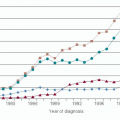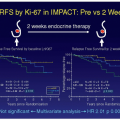The use of breast ultrasound for the characterization of breast masses was described as early as 1966 in a Russian journal (
1). For many years, the primary indication for sonography was to assess if a breast mass was cystic or solid; however, technological advancements in the resolution and speed of breast ultrasound, in addition to its comparatively low cost, have made breast ultrasound a valuable tool in the evaluation of several breast conditions.
TECHNICAL CONSIDERATIONS
The utility of breast ultrasound depends upon two key factors: equipment and who is performing the ultrasound. Breast ultrasound should be performed with a high-frequency linear transducer, 10 MHz or higher. At a minimum, gray-scale ultrasound (also known as “B mode”) is performed, and Doppler ultrasound (either color or Power Doppler) should be used to interrogate for vascularity associated with any lesion. In an effort to better characterize a lesion, such as differentiating a simple from a complicated cyst, harmonic imaging is used. Harmonic imaging takes advantage of the different ultrasound frequencies created by different tissues to create an image (
2). Compound imaging is helpful to reduce image graininess and to produce better characterization of a lesion’s margins. Compound imaging constructs an image by combining ultrasound waves from different angles (
2).
Elastography is another ultrasound tool to help to characterize a lesion. Elastography is the measurement of mass stiffness. In general, a benign mass is stiffer than the adjacent normal breast tissue, and a malignant mass is stiffer than a benign mass. A variety of elastography methods have been proposed. A simple demonstration of elastography is merely applying gentle pressure to the lesion and watching it change in shape or asking the patient to hum during the examination to assess its effect on ultrasound sound waves as they move through the lesion (also known as fremitus). Recently, technological advances have been developed in an effort to standardize elastography performance and interpretation. Formal elastography is not commonly used in most clinical practices, but its use may become more frequent since the new edition of the American College of Radiology (ACR) ultrasound Breast Imaging Reporting and Data System (BI-RADS) is expected in 2014 and may address elastography in image analysis.
IMAGE DOCUMENTATION
The ACR recommends that at least two images be performed of a lesion to document its appearance in orthogonal planes (
3). The ACR Practice Guidelines also recommend image labeling to include clock face position, transducer orientation, and distance from the nipple (
3). Documenting the presence of any internal vascularity associated with the finding is also recommended.
The person who holds the ultrasound transducer is just as important as the technical parameters of ultrasound. The sonographer identifies a lesion and takes representative images. If the operator is inexperienced or inattentive, the opportunity for early detection and appropriate characterization is lost. In many practices, the primary operator is a technologist who may or may not have advanced training in breast imaging; however, it is recommended that the responsible physician checks the relevant ultrasound findings at the time of ultrasound performance or actually performs the ultrasound (
3). Few studies have assessed the accuracy of the different operators; however, interobserver variation exists, especially for lesions smaller than 5 mm (
4).
Once a lesion has been identified and imaged, the radiologist uses the BI-RADS lexicon to characterize the lesion and form a final impression to guide management. The first edition of the ultrasound BI-RADS lexicon was released by the American College of Radiology in 2003. It was modeled after the mammography lexicon mandated by the Mammography Quality and Standards Act of 1992. The lexicon is organized into major categories: mass, calcifications, special cases, vascularity, and final assessment (
5).
The first, and most common, category in the lexicon is “mass.” Once a finding has been confirmed in orthogonal planes, it is further characterized by the descriptors of shape, orientation, margin, lesion boundary, echo pattern, posterior acoustic features, and surrounding tissue. Shape is further subdivided into oval, round, or irregular. Each of these has its own positive predictive value (PPV) for malignancy: oval (16%), round (100%), and irregular (62%) (
6).
Mass orientation relative to the skin is the second descriptor. A mass that is parallel to the skin is more likely to be benign. A mass with an antiparallel orientation to the skin (common described as “taller than wide”) has a PPV for malignancy of 69% (
6).
As with mammography and breast MRI, the margin of a mass is most strongly predictive of malignancy. The margin can be described as circumscribed or noncircumscribed. Noncircumscribed margin descriptors include indistinct, angular, microlobulated, and spiculated. Of the four noncircumscribed descriptors, a spiculated margin has the highest PPV for malignancy (PPV = 86%) (
6).
The last three descriptors are lesion boundary, internal echogenicity, and posterior acoustic features. These descriptors are important but are not the major criteria in the characterization of a mass found by ultrasound. Occasionally, there may be an echogenic border at the mass lesion boundary; this has been associated with malignancy (
7). The internal echogenicity of the mass may be isoechoic, hypoechoic, or hyperechoic relative to the patient’s fat. Although other patterns have been reported, the internal echogenicity of cancers is most commonly hypoechoic (
6). The final mass descriptor relates to the posterior acoustic features of a mass. Increased through transmission is a fundamental feature of a benign simple cyst; however, the classically described posterior acoustic shadowing has been shown to be a weak predictor for malignancy (
6).
The BI-RADS final assessment categories are intended to guide management. If a finding is judged to be BI-RADS 1 (negative) or BI-RADS 2 (benign), routine follow-up is recommended. If a finding is probably benign (BI-RADS 3), short-term follow-up is recommended in 6 months, because the incidence of malignancy in this population is 2% or less (
5). If a finding is suspicious for malignancy, the finding is assessed as a BI-RADS 4, where the expected incidence of malignancy is 3% to 94% (
5). Subcategories of BI-RADS 4 have been created to stratify malignancy risk; however, more study is needed to further define the subcategories. BI-RADS 5 is used when findings are highly suspicious for malignancy. If the needle-guided biopsy is benign, surgical excision is usually recommended to ensure that malignancy was not missed, because the incidence of malignancy in this group is 95% or greater (
5).







